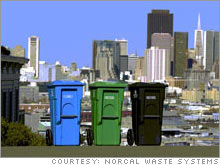Wal-Mart trashes garbageThe suits in Bentonville, Ark., are surprising adherents to the environmental movement's 'zero waste' recycling crusade.NEW YORK (Fortune) -- Wal-Mart and the city of San Francisco do not have much in common, but there is this -- both are working to achieve zero waste. They aren't alone. The Australian territory of Canberra, a third of local governments in New Zealand, the cities of Oakland and Berkeley, a bunch of small towns in California, and Carrboro, N.C., ("Paris of the Piedmont") all have embraced a goal of zero waste.
But what is zero waste? It's just what it sounds like -- the idea that we can design, produce, consume and recycle products without throwing anything away. It's the idea that industry should mimic nature, so that, as the writer Joel Makower put it, "one species' detritus is another's pantry." Zero waste may sound like a crazy `dream, but you can glimpse how a zero waste world might work if you know where to look. Outerwear manufacturer Patagonia makes fleece out of recycled plastic bottles. Herman Miller's Mirra and Celle office chairs can be disassembled in a few minutes for recycling. Xerox (Charts), which aims to "create waste-free products in waste-free facilities," says on its website that it kept 107 million pounds of waste out of landfills in 2005 by reusing and recycling machines, equipment and parts. This isn't a new idea. Sanitation workers used to be called scavengers because they resold everything of value they found. Biologist and activist Barry Commoner wrote about zero waste in a 1971 book called The Closing Circle. But it is a radical idea. The Grass Roots Recycling Network, a group of waste-reduction activists, says: "Zero waste challenges the whole idea of endless consumption without needing to say so," and "poses a fundamental challenge to 'business as usual.'" Interesting, then, that this crusade is getting a boost from Bentonville, Ark. Wal-Mart (Charts) CEO Lee Scott has set a long-term goal of zero waste as part of the giant retailer's march towards sustainability. Over the next two years, Wal-Mart wants to reduce solid waste from its U.S. stores by 25 percent. Scott's reasoning is simple: "If we had to throw it away, we had to buy it first. So we pay twice, once to get it, once to take it away." To Wal-Mart, less waste means lower costs. The company's efforts have begun to bear fruit -- in part by actually recycling fruit. When I visited Wal-Mart's experimental green store in Aurora, Co., last year, workers in the produce department were collecting old fruits and vegetables, as well as cardboard packaging, so they could be made into compost...and sold at Wal-Mart. They also used spent cooking oil as fuel, to help heat the store. Wal-Mart's waste reduction efforts also encompass corn-based (rather than plastic) food packaging because it can be more easily recycled. It has shrunk the size of Sam's Club water bottles. It is also recycling plastic -- and making money doing so -- as the company explains here. More broadly, Wal-Mart is putting pressure on its 60,000 suppliers to reduce packaging of all kinds. Right now, companies that make packaging have little incentive to cut back since they don't pay for disposal. The world's largest retailer may be able to change that. The giant retailer's efforts dovetail with the innovative work being doing by San Francisco's city environment department and its waste contractor, a $500-million year employee-owned company called Norcal Waste Systems. Norcal and the city use a three-bin system to collect refuse from homes and businesses. Garbage goes in a black bin. (The bad guys in the movies wear black hats.) Traditional recyclables, including bottles, cans and paper, go in a blue bin. Food waste and yard trimmings go into a green bin. The green bins of food and yard waste are trucked to a factory 55 miles away in Vacaville, turned into a rich compost called "Four Course Compost" and sold to Napa Valley wineries and farms. Your next glass of California wine may have come from grapes grown in soil fertilized by garbage. Norcal also recycles paper, glass, plastics, construction debris, bulky items, confidential documents and wood waste. "If you can create a quality product -- clean paper, clean glass, wood -- you can find a market for it," says Mike Sangiacomo, the firm's president and CEO. In 2006, San Francisco achieved a 67% diversion rate for its waste. (This differs from a recycling rate, but we'll spare you the details.) That rate should get to 75% before long -- a 2006 "waste characterization study" found that about two-thirds of the garbage that ends up in a landfill is food or paper that could, and should, have landed in the blue or green bins. Getting to zero waste will be much harder, says Jared Blumenfeld, director of San Francisco Environment, a city department. "To get to zero waste," he says, "we need to develop products that can be reused or recycled." His current bugaboo is plastic grocery bags, which litter the landscape, gum up recycling machines and worse. "From our perspective, waste doesn't need to exist," Blumenfeld says. "It's a design flaw." Getting to zero waste will take time. Big industries, ranging from landfill owners to the makers of plastic packages, like things the way they are. Trucking garbage to dumps is often the cheapest way to get rid of it, at least for now. Even the Grass Roots Recycling Network says: "In profitability, landfill is at the top of the scale, while recycling remains at the bottom." But in the long run -- or perhaps the very long run -- the costs of dumping in landfills will increase, as will the price of oil, the expense of chopping down trees to make paper, the damage caused by chemical fertilizers that could be replaced by compost, and so forth. That will improve the economics of recycling. |
|

